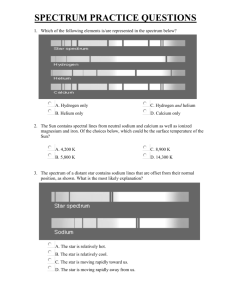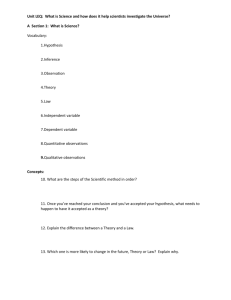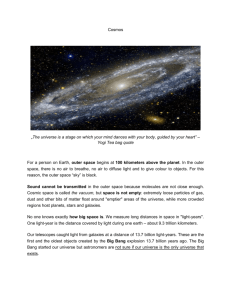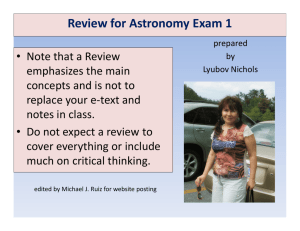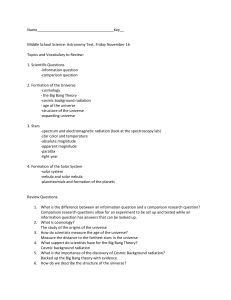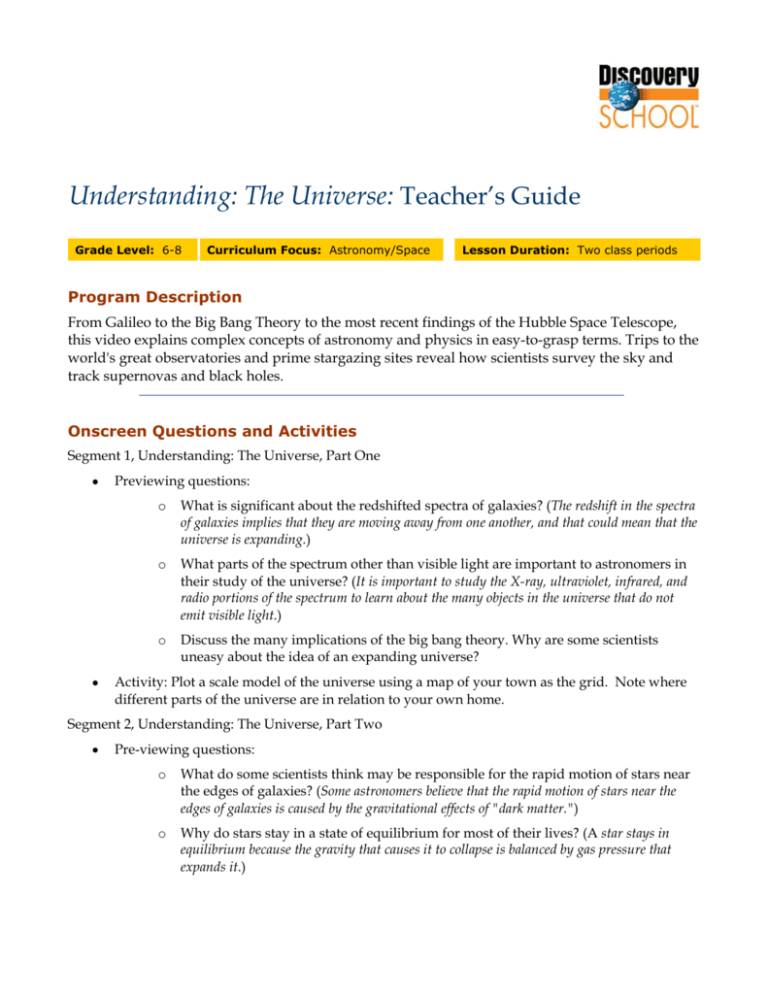
Understanding: The Universe: Teacher’s Guide
Grade Level: 6-8
Curriculum Focus: Astronomy/Space
Lesson Duration: Two class periods
Program Description
From Galileo to the Big Bang Theory to the most recent findings of the Hubble Space Telescope,
this video explains complex concepts of astronomy and physics in easy-to-grasp terms. Trips to the
world's great observatories and prime stargazing sites reveal how scientists survey the sky and
track supernovas and black holes.
Onscreen Questions and Activities
Segment 1, Understanding: The Universe, Part One
•
•
Previewing questions:
o
What is significant about the redshifted spectra of galaxies? (The redshift in the spectra
of galaxies implies that they are moving away from one another, and that could mean that the
universe is expanding.)
o
What parts of the spectrum other than visible light are important to astronomers in
their study of the universe? (It is important to study the X-ray, ultraviolet, infrared, and
radio portions of the spectrum to learn about the many objects in the universe that do not
emit visible light.)
o
Discuss the many implications of the big bang theory. Why are some scientists
uneasy about the idea of an expanding universe?
Activity: Plot a scale model of the universe using a map of your town as the grid. Note where
different parts of the universe are in relation to your own home.
Segment 2, Understanding: The Universe, Part Two
•
Pre-viewing questions:
o
What do some scientists think may be responsible for the rapid motion of stars near
the edges of galaxies? (Some astronomers believe that the rapid motion of stars near the
edges of galaxies is caused by the gravitational effects of "dark matter.")
o
Why do stars stay in a state of equilibrium for most of their lives? (A star stays in
equilibrium because the gravity that causes it to collapse is balanced by gas pressure that
expands it.)
Understanding: The Universe: Teacher’s Guide
o
•
2
Discuss some of the inconsistencies in our understanding of the universe. Structure
the discussion after the debates highlighted in the documentary.
Activity: Divide the class into groups and discuss selected science fiction movies in terms of
their accurate depiction of space travel. What laws of physics are violated for the purpose of
entertainment?
Lesson Plan
Student Objectives
Students will understand:
•
The stages of evolution a star goes through are determined by the size of the star.
Materials
•
Understanding: The Universe video and VCR, or DVD and DVD player
•
Research materials about stars and the evolution of stars
•
Computer with Internet access
Procedures
1. Review with your students what they have learned about stars. In the course of discussion,
determine how much they know about star evolution.
2. If students do not fully understand the terms red giant, white dwarf, neutron star, supernova, and
black hole, have them use the research materials you have provided or the Internet to become
acquainted with the terms and understand how they relate to the evolution of stars of different
sizes.
3. Before continuing the activity, students should know the following three facts:
•
A star the size of our sun will burn steadily for 10 billion years, then expand to a red
giant, and finally collapse into a white dwarf about the size of Earth.
•
A star three or four times the sun’s mass will burn steadily for a shorter time, then
expand into a red giant, and finally collapse, ending up as a neutron star—a superdense star about the size of a large city.
•
A star 50 times the sun’s mass will burn for an even shorter time and may blow up
as a supernova before collapsing and eventually shrinking to infinity, becoming a
black hole.
4. Divide the class into three groups, and assign the students in each group to focus on one of the
three types of stars just mentioned: a star the size of our sun, a star three or four times the sun’s
mass, and a star 50 times the sun’s mass.
Published by Discovery Education. © 2005. All rights reserved.
Understanding: The Universe: Teacher’s Guide
3
5. Have each student use her or his prior knowledge and information from research to draw a
carefully labeled set of diagrams illustrating the stages in the evolution of the type of star his or
her group has been assigned.
6. Display students’ diagrams in the classroom so that the class can use them to compare the
stages of evolution of the three different types of stars.
Discussion Questions
1. Discuss why some scientists were uneasy about the idea of an expanding universe.
2. Astronomer Wendy Freedman's observations of Cepheid variable stars in another galaxy
indicated that the age of the universe is about eight to twelve billion years. Why did her
discovery cause such a debate among astronomers? What elements of her discovery still lend
themselves to argument?
3. What do scientists learn by observing parts of the universe in other than the visible parts of the
spectrum?
4. What materials are believed to compose dark matter, and what can we learn about the universe
by examining it?
Assessment
Use the following three-point rubric to evaluate students' work during this lesson.
•
3 points: Student diagrams carefully prepared; labels clear and correct; diagrams accurately
illustrate the star’s stages of evolution.
•
2 points: Student diagrams adequately prepared; some labels unclear or incorrect; diagrams
accurately illustrate the star’s stages of evolution.
•
1 point: Student diagrams carelessly prepared; labels unclear and/or incorrect; diagrams reflect
some inaccurate information about the star’s stages of evolution.
Vocabulary
Cepheid variables
Definition: A class of giant, pulsating stars, whose brightness varies in a periodic manner, which
is used to measure distance in astronomy.
Context: Edwin Hubble was studying a distinctive kind of star called a Cepheid variable.
globular cluster
Definition: A compact, spherical-shaped cluster of stars that shares a common gravitational
association.
Context: We're looking at globular star clusters - 100,000 to 1,000,000 stars.
Published by Discovery Education. © 2005. All rights reserved.
Understanding: The Universe: Teacher’s Guide
4
light-year
Definition: In astronomy, the unit of length used to measure distance i.e. the distance that light
traveling in a vacuum covers in one year.
Context: They say the star is four and a third light-years away.
red shift
Definition: The shift toward the longer wavelength, or red section, of the spectrum.
Context: It was Hubble who recognized the significance of the red shift in the light.
spectrum
Definition: The distribution of electromagnetic radiation from a radiant source, spread out into
wavelengths or frequencies.
Context: Visible light, the rainbow of red to violet, is a small slice of a larger spectrum.
Academic Standards
Mid-continent Research for Education and Learning (McREL)
McREL's Content Knowledge: A Compendium of Standards and Benchmarks for K-12 Education
addresses 14 content areas. To view the standards and benchmarks, visit http://www.mcrel.org/.
This lesson plan addresses the following national standards:
•
Science—Space Science: Understands essential ideas about the composition and structure of
the universe and the Earth's place in it.
•
Science—Physical Science: Understands motion and the principles that explain it.
•
Science—Physical Science: Knows the kinds of forces that exist between objects and within
atoms.
National Academy of Sciences
The National Science Education Standards provide guidelines for teaching science as well as a coherent
vision of what it means to be scientifically literate for students in grades K-12. To view the standards,
visit http://books.nap.edu.
This lesson plan addresses the following science standards:
•
Origin and evolution of the universe
Published by Discovery Education. © 2005. All rights reserved.

